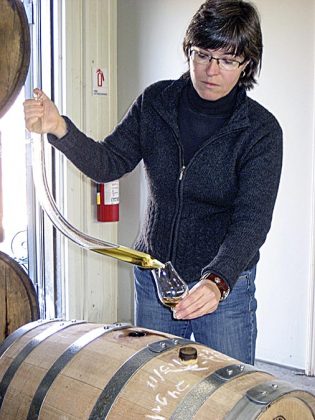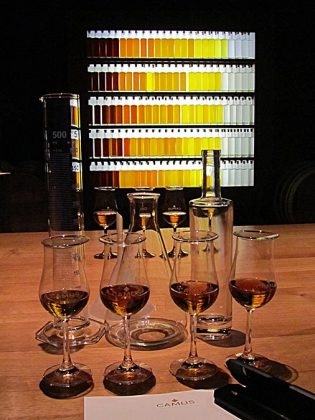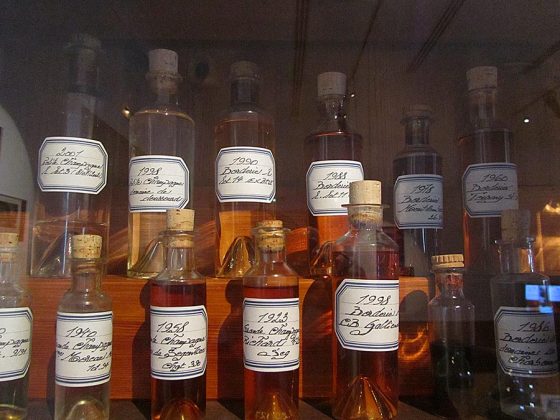One day last winter, I visited a local craft distillery to collect samples of barrel drippings for use in my blending lab. The distiller, taking a much-needed break from his work, followed me around from barrel to barrel as I carefully removed the blackish sap with my knife and placed the scrapings into a small glass jar. We were casually chatting when he mentioned that he would soon be bottling a new batch of whiskey. Since I was aware that he was relatively new to the industry, I asked him if he could use some help with the blending and reduction of his product. “Oh, no thanks,” he scoffed, clearly offended by the audacity of my suggestion, “This is going to be a malt whiskey. We only make single malt whiskeys and Bourbons here, not blends.”
This distiller was confusing the art of blending with commercial use of the term “blended whisky.” Unfortunately this sentiment is quite prevalent with both whiskey connoisseurs and producers alike, such that the word “blend” has become anathema within the American whiskey lexicon. The term is frequently equated with certain types of Scotch, American, or Canadian whiskeys that incorporate neutral spirits into the blending process. Although these regional differences are dictated by the laws of their respective countries, they generally consist of more neutral, cheaper grain spirits with a small percentage of barley malt or Bourbon, are sourced from numerous distilleries (in the case of Scotch), and are mixed together in such a way as to produce a lighter, smoother, more consumer-friendly drink. Blends are often imagined in contradistinction to single malt or Bourbon, which are thought of as “superior” to blended whiskeys due to their more robust, flavorful profiles. The fact is that most single malt and bourbon releases are blended from a large variety of barrels. The now-popular and expensive Japanese single malts are often comprised of dozens of whiskies produced by a variety of grain bills and
receiving different barrel treatments produced by one house.
However, this particular understanding of the term “blend” is only a small part of what the term has historically meant – and what it continues to mean – within the brown-spirits producing regions of the world. In a larger sense, blending is a process whereby constituent parts are skillfully assembled in such a way as to create a greater, well-balanced, and more complex whole. Thus, even the barrels of single malt whiskey, straight Bourbon whiskey, and other such distillates must be mixed in such a way so as to produce a product whose whole is greater than the sum of its parts. Occasionally, a single barrel of a spirit will be good enough to release on its own merit, but this is rare and usually accompanied by the term single barrel for marketing advantages.
In most of the brown-spirits-producing regions of the world, such as Scotland, France, the Caribbean and Central and South America, the jobs of distilling and blending have historically been (and still are) bifurcated, so that a distillery will have both a Master Distiller and a Master Blender. In these traditions, more emphasis is usually placed upon the role of the Master Blender. Both titles are attained after decades of rigorous apprenticeship. These jobs have a reputation for being hard-earned, and because of that, they are well respected.
In the bourbon industry, oversight of distilling, maturation and blending are collapsed into one role — the Master Distiller. This role, like that of its European, Caribbean, and Central and South American counterparts, is also attained after many years of apprenticeship. It is easy to see how the bourbon master distiller model is the one that has been most closely followed by U.S. craft distilleries. For craft distillers, however, the role of the distiller — the person who is actually running the still – is what tends to be promoted to consumers as the most significant role in production.
In the same vein, craft distillers often adopt the Bourbon industry’s methods of distilling, maturation, blending and reduction for all of their products. While this model works well for producing bourbons and whiskeys, it is not always the most appropriate one to use in order to create high-quality rums or alambic-style brandies. Few craft producers are even aware of the maturation, blending, and reduction methods used to create these spirits.
For many craft distillers, the process of reduction to desired proof is often based on the bourbon industry model of a one-time dump. If one is producing an alambic-style brandy, there is a danger the brandy will saponify when it goes very quickly from barrel proof to 40% ABV. Various methods of gradual reduction have been developed over centuries to bring the spirit to proof over a course of years, not minutes. Blends are married in barrels over a course of months instead of days (or hours) before bottling. Some of these methods may or may not apply to whiskey production, but the results for other classes of spirits have been proven to yield better results and deserve consideration in a
creative industry.
In fact, many distillers have come to the industry from other walks of life, and have pursued their dream of owning and running a distillery. Because they have not had the benefit of apprenticing with a master, their understanding of the role of the Master Blender has taken a back seat to the role of the distiller.
The role of the blender seems to be diminished by educational programs within the craft distilling movement. Collectively, we educators are partly responsible for giving primacy to the roles of fermenting and distilling, while the role of running the barrel warehouse and the art of blending barrels has taken a back seat. In most distilled spirits educational curriculums or seminars, the comprehensive topics of warehousing, blending and reduction theories, and bottling are quite short when compared to the topics of malting, fermentation, and distillation. When the back side of production is taught, it is usually in reference to some aspect of the barrel, such as size, toast and/or char, chemical reactions, theories of accelerated maturation, proofing, etc. Fortunately, this trend has slowly been changing in the past couple of years, and more programs are beginning to offer more in-depth maturation and blending classes.
Finally, craft distilleries are expensive to start and operate, and are usually small to medium-sized operations. One person, sometimes with little formal training, is in charge of all aspects of production. It is often not feasible to hire a trained cellar master whose sole job is to tend the warehouse or barrel room, and blend and bottle the spirit when it is ready. Moreover, the lack of such available people, and the lack of barrel inventory when starting out makes this alternative negligible. Thanks to Prohibition, the distilling movement in the US is in its infancy and there are not a lot of mature spirits available for the current generation to work with. Most distillers do not have decades-old barrels from which to create blends.
In calling attention to this lacuna within the craft distilling industry, my aim is not to be critical of craft distillers, but rather to help raise awareness of the issue, and hopefully to find positive solutions on how this gap in knowledge can be bridged. The ultimate goal here is to help educate craft distillers so that they can learn to give as much care and attention to the back end of production as they give to the front end.
Craft distillers need more information about how to construct an effective wood policy and barrel management program, and how to create quality, consistency, and complexity with every batch. The lack of general knowledge in these areas among distillers is usually not for the lack of desire to understand. More awareness is needed on how to properly house barrels, and how good sanitary practices will keep barrels from developing offensive odors from sources within the distillery.
I have at times seen open fermenters or buckets of chemicals housed next to barrels full of spirits, or wash hoses that obviously had not been emptied properly left on a cement floor with liquid inside waiting to go rancid and exposing this expensive piece of equipment to potential damage from being trod on. The worst-case scenario was witnessing a pile of aging dog poop in a barrel room and dog hair flying wildly around the barrels. Oak is an organic, porous material. The molecules of foul odors can and will be absorbed by those barrels, thus integrating into the spirit within. Perhaps one small mishap in a barrel room might not affect the character of a spirit, but a series of them will add up to serious aromatic harm.
So, what is so unique about the role of the cellar master/blender? Looking at the timeline of the life of a barrel-matured spirit, it spends only a fraction of its life in the fermentation and distillation phases compared to the maturation phase. The maturation phase of its life in the barrel can span 50 years or more, depending on the type of spirit. In fact, this stage in the life of a spirit is so important that French Cognac producers have a name for it: elevage. This concept refers to the art of maturation, but it is really more than that. In brief, elevage literally means “to educate or raise” a spirit (or wine), much as one would bring up a child, and to give it the proper nurturing and care in order to bring out its quality to maximum potential.
In order to achieve this feat, the cellar master must understand how the storage medium (i.e, the barrel) and the storage conditions within the barrel room or warehouse affect the maturation of the spirit, and how these two things can be manipulated in order to create desired aroma and flavor profiles. Perhaps most importantly, the master blender must also have a sensitive nose, a good memory for aromas, and an understanding of how the various esters, acids, aldehydes, phenols, acetals, and carbonyl compounds found within a matured distillate interact when blended.
During my time working as a behind-the-scenes Ghost Blender, I have noticed that this last requirement – that of sensitivity to and knowledge of aromas – is the often the most challenging for some craft distillers. Again, it is not through a lack of concern on their part; rather, it is because they have not had enough experience in detecting them. Some cannot even detect basic faults within their product, much less more subtle notes, and do not have a sense of how to target and eliminate these faults.
For other craft distillers, mastering the art of balance in their products is a challenge. The goal in blending is for all of the parts come together in a pleasing, harmonious, and highly quaffable whole. Distilleries should be creative and push the boundaries with their spirits but too much of a good thing can have undesired consequences. The use of innovative production techniques, such as oak and other wood alternatives, various smoking grains, accelerated maturation, the addition of hops, non-standard grains, grapes, or cane, permitted additives, etc, can give exciting new expressions to tired old categories. Yet, distillers will often overuse these techniques in ways that throw their spirits out of balance. Even with innovation, a blender should always strive to keep the balance and structure of the spirit intact.
In the long term, raising awareness among craft distillers of the many traditions and theories of blending, proper warehouse and barrel management, development of wood policies, etc., will be beneficial to the quality of spirits produced. Of course, hiring a blender whose sole job is to attend to the back end of production may not be a feasible solution for many distilleries. Most distillers have enough already on their plates just in running their businesses, so taking time to travel the world to visit and converse with Master Blenders is not a likely solution.
The more energy and attention that craft distillers devote to sensory analysis, blending, etc., the more awareness will evolve. Consultants and instructors can do our part to raise awareness of these issues among clients and students. The more daily practice distillers get to consciously develop good warehousing, sensory, and blending skills, the more adept they will become. Together as an industry, we can work toward this goal in order to continually evolve our craft and to create the best quality spirits of which we are capable.
Let’s start giving the back end its due!













